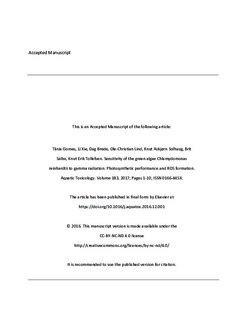| dc.contributor.author | Gomes, Tania | |
| dc.contributor.author | Xie, Li | |
| dc.contributor.author | Brede, Dag Anders | |
| dc.contributor.author | Lind, Ole Christian | |
| dc.contributor.author | Solhaug, Knut Asbjørn | |
| dc.contributor.author | Salbu, Brit | |
| dc.contributor.author | Tollefsen, Knut Erik | |
| dc.date.accessioned | 2018-10-26T12:20:40Z | |
| dc.date.available | 2018-10-26T12:20:40Z | |
| dc.date.created | 2017-01-06T15:03:05Z | |
| dc.date.issued | 2017 | |
| dc.identifier.citation | Aquatic Toxicology. 2017, 183, 1-10. | nb_NO |
| dc.identifier.issn | 0166-445X | |
| dc.identifier.uri | http://hdl.handle.net/11250/2569792 | |
| dc.description | Embargo until December 06 2018. | nb_NO |
| dc.description.abstract | The aquatic environment is continuously exposed to ionizing radiation from both natural and anthropogenic sources, making the characterization of ecological and health risks associated with radiation of large importance. Microalgae represent the main source of biomass production in the aquatic ecosystem, thus becoming a highly relevant biological model to assess the impacts of gamma radiation. However, little information is available on the effects of gamma radiation on microalgal species, making environmental radioprotection of this group of species challenging. In this context, the present study aimed to improve the understanding of the effects and toxic mechanisms of gamma radiation in the unicellular green algae Chlamydomonas reinhardtii focusing on the activity of the photosynthetic apparatus and ROS formation. Algal cells were exposed to gamma radiation (0.49–1677 mGy/h) for 6 h and chlorophyll fluorescence parameters obtained by PAM fluorometry, while two fluorescent probes carboxy-H2DFFDA and DHR 123 were used for the quantification of ROS. The alterations seen in functional parameters of C. reinhardtii PSII after 6 h of exposure to gamma radiation showed modifications of PSII energy transfer associated with electron transport and energy dissipation pathways, especially at the higher dose rates used. Results also showed that gamma radiation induced ROS in a dose-dependent manner under both light and dark conditions. The observed decrease in photosynthetic efficiency seems to be connected to the formation of ROS and can potentially lead to oxidative stress and cellular damage in chloroplasts. To our knowledge, this is the first report on changes in several chlorophyll fluorescence parameters associated with photosynthetic performance and ROS formation in microalgae after exposure to gamma radiation. | nb_NO |
| dc.language.iso | eng | nb_NO |
| dc.publisher | Elsevier | nb_NO |
| dc.rights | Attribution-NonCommercial-NoDerivatives 4.0 Internasjonal | * |
| dc.rights.uri | http://creativecommons.org/licenses/by-nc-nd/4.0/deed.no | * |
| dc.title | Sensitivity of the green algae Chlamydomonas reinhardtii to gamma radiation: Photosynthetic performance and ROS formation | nb_NO |
| dc.type | Journal article | nb_NO |
| dc.type | Peer reviewed | nb_NO |
| dc.description.version | acceptedVersion | nb_NO |
| dc.source.pagenumber | 1-10 | nb_NO |
| dc.source.volume | 183 | nb_NO |
| dc.source.journal | Aquatic Toxicology | nb_NO |
| dc.identifier.doi | 10.1016/j.aquatox.2016.12.001 | |
| dc.identifier.cristin | 1422512 | |
| dc.relation.project | Norges forskningsråd: 223268 | nb_NO |
| cristin.unitcode | 7464,20,13,0 | |
| cristin.unitname | Økotoksikologi | |
| cristin.ispublished | true | |
| cristin.fulltext | postprint | |
| cristin.qualitycode | 2 | |

